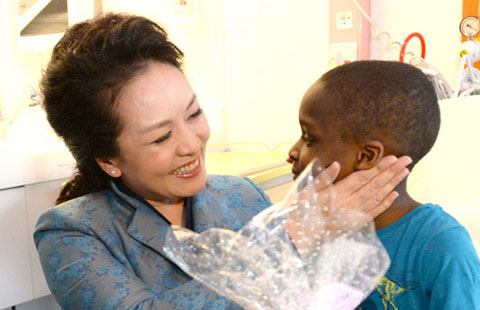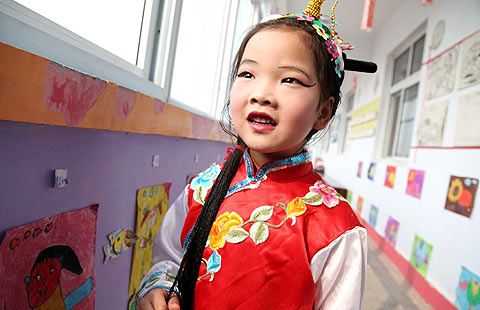
|
Yao Yun, chairwoman of Guangdong Jiaduo Trading Co, with children from Cote d'Ivoire. Yao is planning to set up a factory in the West African country. Provided to China Daily |
Manufacturers seek new locations to stay profitable
Their haven against ever rising labor costs in China used to be Southeast Asia, but that seems to have outlived its usefulness, and now the bolt-hole of choice for many has become Africa.
For Yao Yun, whose Guangdong Jiaduo Trading Co Ltd makes activated carbon products, used in airconditioning and air and water purifiers, the latest move has taken three years, and she has no doubt it has been worth it.
Yao's products were initially made in Dongguan, Guangdong province. In its manufacturing, the company uses raw materials such as palm shells, coconut shells and rubber, which it buys from Southeast Asian countries and from Africa.
In 2007, to gain easier access to raw materials and to save on transport costs, Yao opened a factory in Johor, Malaysia, with three production lines. From there she sold products to the world, including China.
The move to Johor paid off handsomely for Guangdong Jiaduo Trading, but within three years things began to change, Yao says.
"Malaysia was originally the largest exporter of palm shells and coconut shells with most buyers worldwide, but as everyone tried to get a piece of the action, prices rose.
"From 2010 I noticed that the same products imported from Africa became much cheaper than those from Southeast Asia, and I started replacing suppliers in Southeast Asia with ones in Africa."
Cost pressures on the company have been exacerbated in the past three years because of the increasing worldwide demand for activated carbon products, forcing her to find other raw materials suppliers, she says.
Among the big winners in all this have been Cote d'Ivoire, Ghana and other countries in West Africa where Yao now buys more than half of her raw materials, much more cheaply than would be the case in Malaysia.
After that profitable switch she is now looking at greater possibilities for her company in Africa.
"If the proportion of raw materials we buy from there keeps increasing, transport costs will become exorbitant, so I am thinking of opening a factory there," Yao says.
As with Yao, it is cost pressures that have driven Li Shaoxing, chairman of Huaxia Machinery Plastics Co Ltd in Zhengzhou, Henan province, to Africa.
Over the past 20 years, he says, his company's goal has been to have profit margin of between 20 percent and 30 percent. But in 2000, when the profit margin was down to 5 percent, with no improvement in sight, Li decided that he needed to get out of China.
"I was convinced the advantage of cheap production in China would eventually disappear, and after two years' research we began afresh in Bac Giang province in Vietnam."
Li's factory, with four production lines covering three hectares, opened in 2003, and was one of the first to be set up by Chinese business people in Vietnam.
"We started making and selling plastic woven bags to Vietnamese buyers when we moved there and expanded exports five years later," he says.
After the move, Huaxia Machinery Plastics managed to obtain a profit margin of 30 percent before 2008 and then set up another factory with 20 production lines to meet increasing international demand, Li says.
"Over those five years we expanded and the number of orders increased."
However, competition became tough as more Chinese companies poured into Vietnam to take advantage of its low labor costs.
"As more factories opened, and with the limited number of workers, those costs rose rapidly," Li says.
By 2011 he found himself essentially with the same problem he had faced in China 11 years earlier: the company's profit margin had slipped to 5 percent, and in 2012 it had slipped even further, to 3 percent.
For Li the writing was on the wall yet again, with a new solution: Africa.
His company is now building a factory in Ethiopia, that will make goods for certain European countries and that will open in a year or two, he says.
Li says he has no plans to abandon the factories in Vietnam, which will make goods mainly for local buyers and regular US and large European customers not apt to switch to other suppliers and willing to accept higher prices.
"Africa will be my major focus in two or three years. To save on costs, it will be staffed by local employees and managers from China."
It is not only cost-cutting that is driving Chinese to Africa. Yao Yun, having had a foretaste of the opportunities the continent offers, has cast her net wider and begun investing in property.
Early last year, she says, she invested 20 million yuan ($3.3 million) in a government-run affordable housing project in Cote d'Ivoire.
"There is a guaranteed return that will be put into other government projects in Africa to reap even greater returns."
Such projects are sprouting up all over Africa, and they offer great opportunities for investors, she says.
yuran@chinadaily.com.cn
(China Daily Africa Weekly 03/14/2014 page13)








